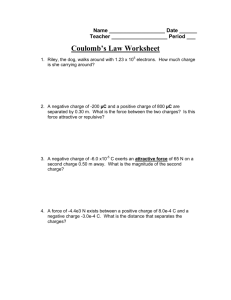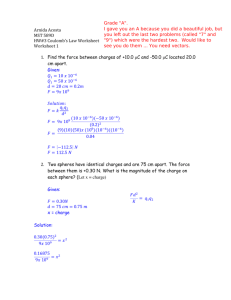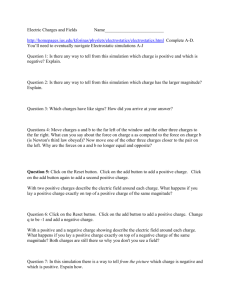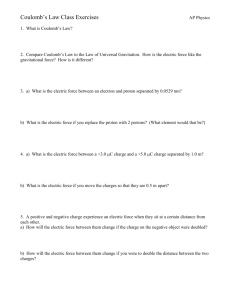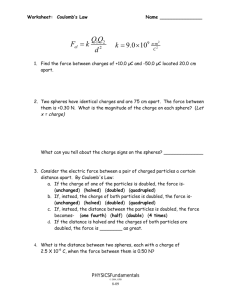Worksheet - Coulomb's Law
advertisement
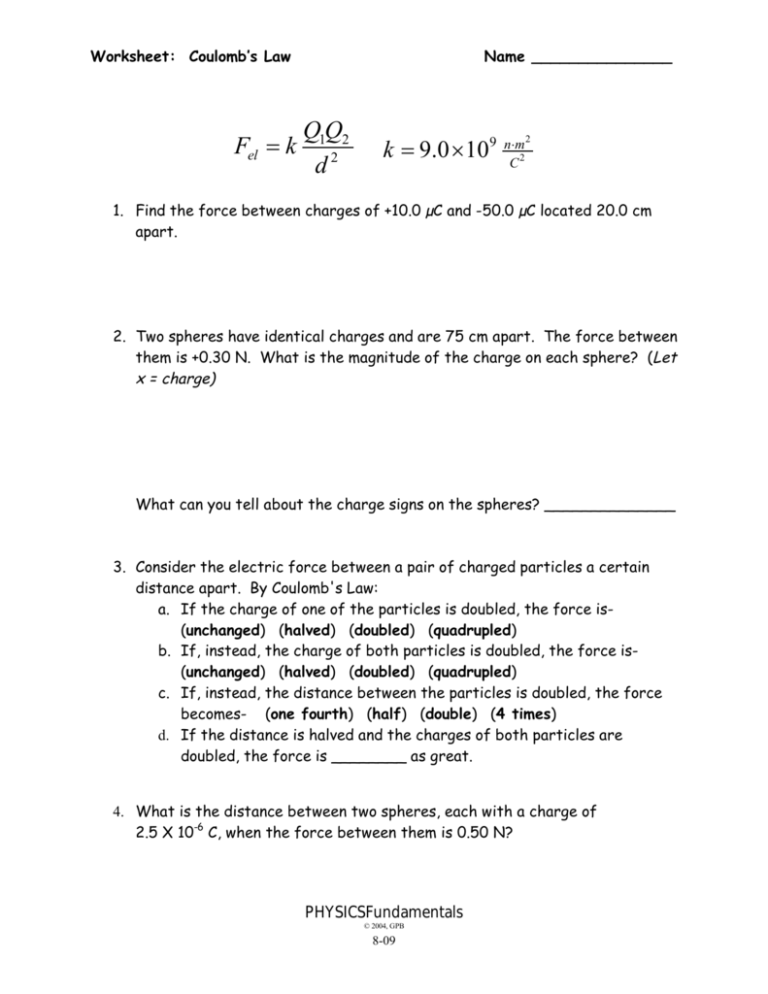
Worksheet: Coulomb’ s Law Fel k Name _______________ Q1Q2 d2 k 9.0 109 n m2 C2 1. Find the force between charges of +10.0 µC and -50.0 µC located 20.0 cm apart. 2. Two spheres have identical charges and are 75 cm apart. The force between them is +0.30 N. What is the magnitude of the charge on each sphere? (Let x = charge) What can you tell about the charge signs on the spheres? ______________ 3. Consider the electric force between a pair of charged particles a certain distance apart. By Coulomb's Law: a. If the charge of one of the particles is doubled, the force is(unchanged) (halved) (doubled) (quadrupled) b. If, instead, the charge of both particles is doubled, the force is(unchanged) (halved) (doubled) (quadrupled) c. If, instead, the distance between the particles is doubled, the force becomes- (one fourth) (half) (double) (4 times) d. If the distance is halved and the charges of both particles are doubled, the force is ________ as great. 4. What is the distance between two spheres, each with a charge of 2.5 X 10-6 C, when the force between them is 0.50 N? PHYSICSFundamentals © 2004, GPB 8-09 Name: Period: Subject: Date: Worksheet - Coulomb’s Law 1. A negative charge of - 2.0 C and a positive charge of 3.0 C are separated by 80 m. What is the force between the two charges? 2. A negative charge of - 0.0005 C exerts an attractive force of 9.0 N on a second charge that is 10 m away. What is the magnitude of the second charge? 3. Two negative charges that are both - 3.0 C push each other apart with a force of 19.2 N. How far apart are the two charges? 4. A negative charge of - 4.0 x 10 -5 C and a posivite charge of 7.0 x 10 -5 C are separated by 0.15 m. What is the force between the two charges? 5. A negative charge of - 8.0 x 10 -6 C exerts an attractive force of 12 N on a second charge that is 0.050 m away. What is the magnitude of the second charge? 6. Two negative charges that are both - 5.0 x 10 -5 C push each other apart with a force of 15 N. How far apart are the two charges? Unit I - Worksheet 3: Coulomb's Law Key q1q2 , where r2 2 k = 9.0 × 109 Nm 2 , describe in words the relationship among electric force, charge, and C distance. 1. Given the mathematical representation of Coulomb’s Law, F = k 8LI ¾VWX WM\ TVSFPIQW SR XLMW TEKI EVI QSVI VITMXMXMSRW SJ XLI IEVP] TVSFPIQW 2. By how much does the electric force between a pair of charged bodies diminish when their separation is doubled? tripled? *IIP JVII XS WOMT XLI ¾VWX TVSFPIQW 8LI ¾REP TVSFPIQW EVI QSVI EHZERGIH 3. Two positive charges of 6.0 x 10-6 C are separated by 0.50 m. Draw a force diagram for each of the charges, considering only electrostatic forces. What is the magnitude of the force between the charges? Is this force repulsive or attractive? XLER ER]XLMRK TVIZMSYW +MZI XLIQ E WLSX 4. A negative charge of 2.0 x 10-4 C and a positive charge of 8.0 x 10-4 C are separated by 0.30 m. What is the magnitude of the force between the charges? Is this force repulsive or attractive? 5. A young man accumulates a charge q1 of +2.0 x 10-5 C while sliding out of the front seat of a car. His girlfriend, who had been waiting in the wind, has picked up some extra electrons and now has a charge q2 of -8.0 x 10-5 C. Draw a sketch of the situation. Estimate the magnitude of the electrical force that each person exerts on the other when separated by a distance of 6.0 m. Is the force attractive or repulsive? 6. Suppose the two people in the previous problem move toward each other. Calculate the magnitude of the electrical force of one on the other when their separation is reduced by a factor of 10. 7. The figure below shows three point charges that lie along the x axis. Determine the magnitude and direction of the net electrostatic force on charge q1. ­6 ­6 + 6.0 x 10 C ­ 4.0 x 10 C 0.20 m ©Modeling Workshop Project 2003 ­6 ­ 7.0 x 10 C 0.15 m 1 E1-Charge&Field ws3 v3.0 7. Two pith balls shown in the diagram below have a mass of 1.0 g each and have equal charges. One pith ball is suspended by an insulating thread. The other charge is brought to within 3.0 cm. of the suspended ball (r = 0.03 m). The suspended pith ball is deflected from its rest position until the thread forms an angle of 30˚ with the vertical. At this angle, the ball is in equilibrium. a) Draw a force diagram depicting the forces acting on the suspended ball. Calculate (b) mg (c) FE (d) the charge on the pith balls FT 30o 30 Fe Fg 0.03 m 9. Three charges are placed as shown below. Determine the magnitude and direction of the net electrostatic force on charge q1. As part of the solution, include a force diagram. ­5 + 1.8 x 10 C 3.0 m ­5 ­ 1.2 x 10 C ©Modeling Workshop Project 2003 3.0 m ­5 + 4.5 x 10 C 2 E1-Charge&Field ws3 v3.0


